A Comprehensive Report on Nike's Market Performance & Elasticity
VerifiedAdded on 2023/06/15
|7
|1363
|182
Report
AI Summary
This report provides an analysis of Nike's market performance, focusing on key economic concepts such as price elasticity of demand (PED), income elasticity of demand (YED), and market equilibrium. The PED is calculated for 2021, comparing it to 2020, highlighting the impact of the Coronavirus pandemic on consumer behavior and health awareness. The report also calculates YED, noting the increasing awareness of health and its positive impact on Nike's sales among affluent consumers. Furthermore, the report explains Nike's market equilibrium with consideration of factors like alternative products and consumer income portions. It also refers to the relative prices of supply concept, which describes how a person's amount provided responds to a cost increase. References to academic journals and books are included to support the analysis.
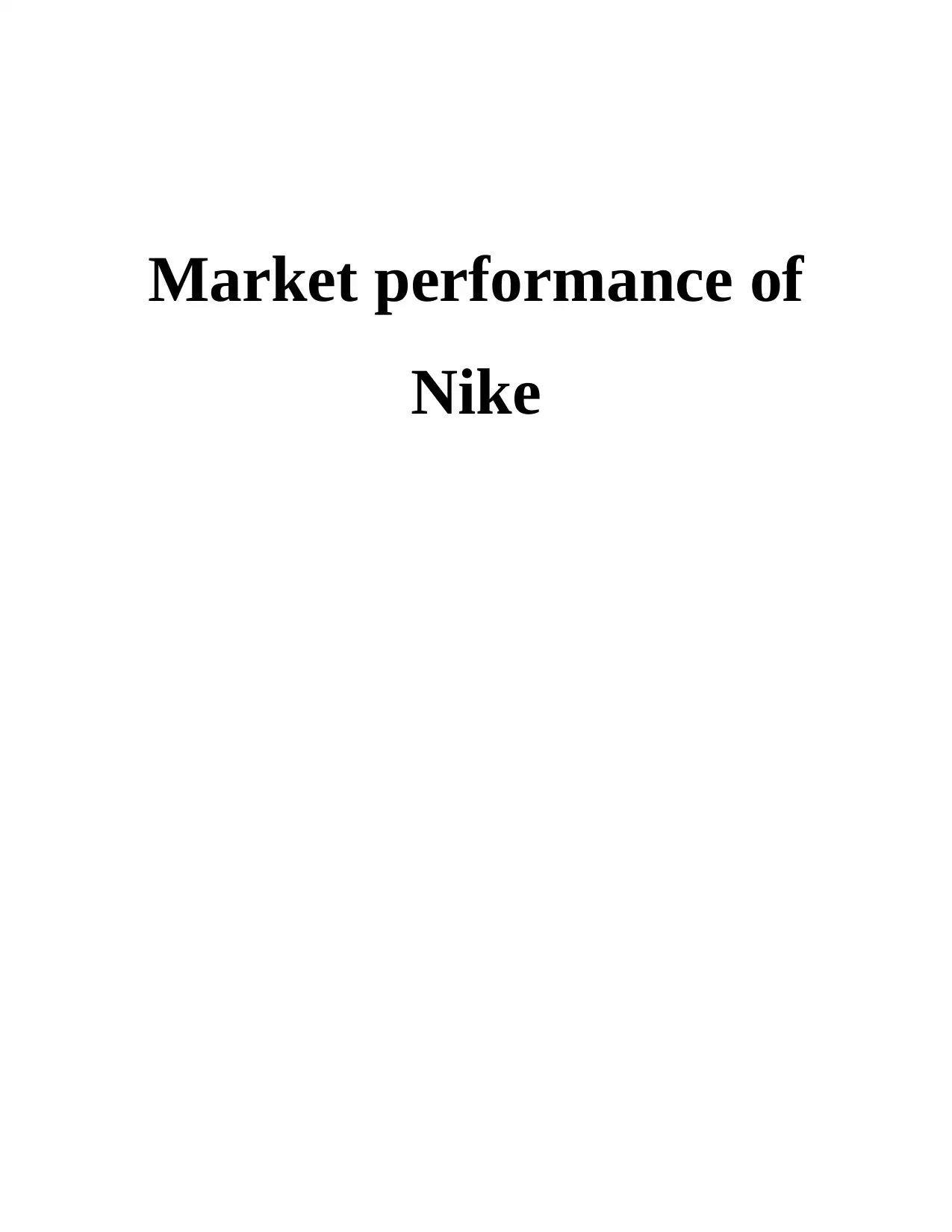
Market performance of
Nike
Nike
Paraphrase This Document
Need a fresh take? Get an instant paraphrase of this document with our AI Paraphraser
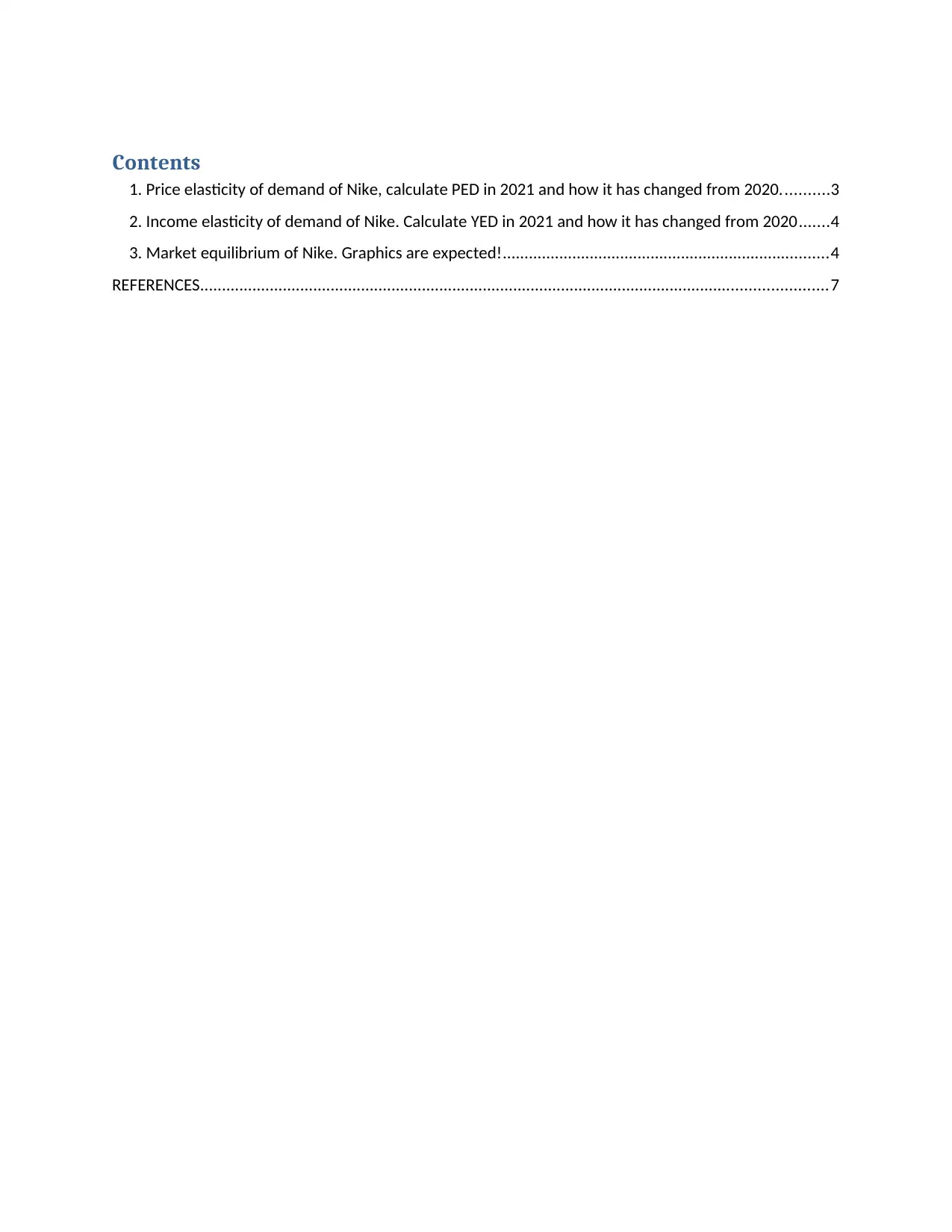
Contents
1. Price elasticity of demand of Nike, calculate PED in 2021 and how it has changed from 2020...........3
2. Income elasticity of demand of Nike. Calculate YED in 2021 and how it has changed from 2020.......4
3. Market equilibrium of Nike. Graphics are expected!...........................................................................4
REFERENCES................................................................................................................................................7
1. Price elasticity of demand of Nike, calculate PED in 2021 and how it has changed from 2020...........3
2. Income elasticity of demand of Nike. Calculate YED in 2021 and how it has changed from 2020.......4
3. Market equilibrium of Nike. Graphics are expected!...........................................................................4
REFERENCES................................................................................................................................................7
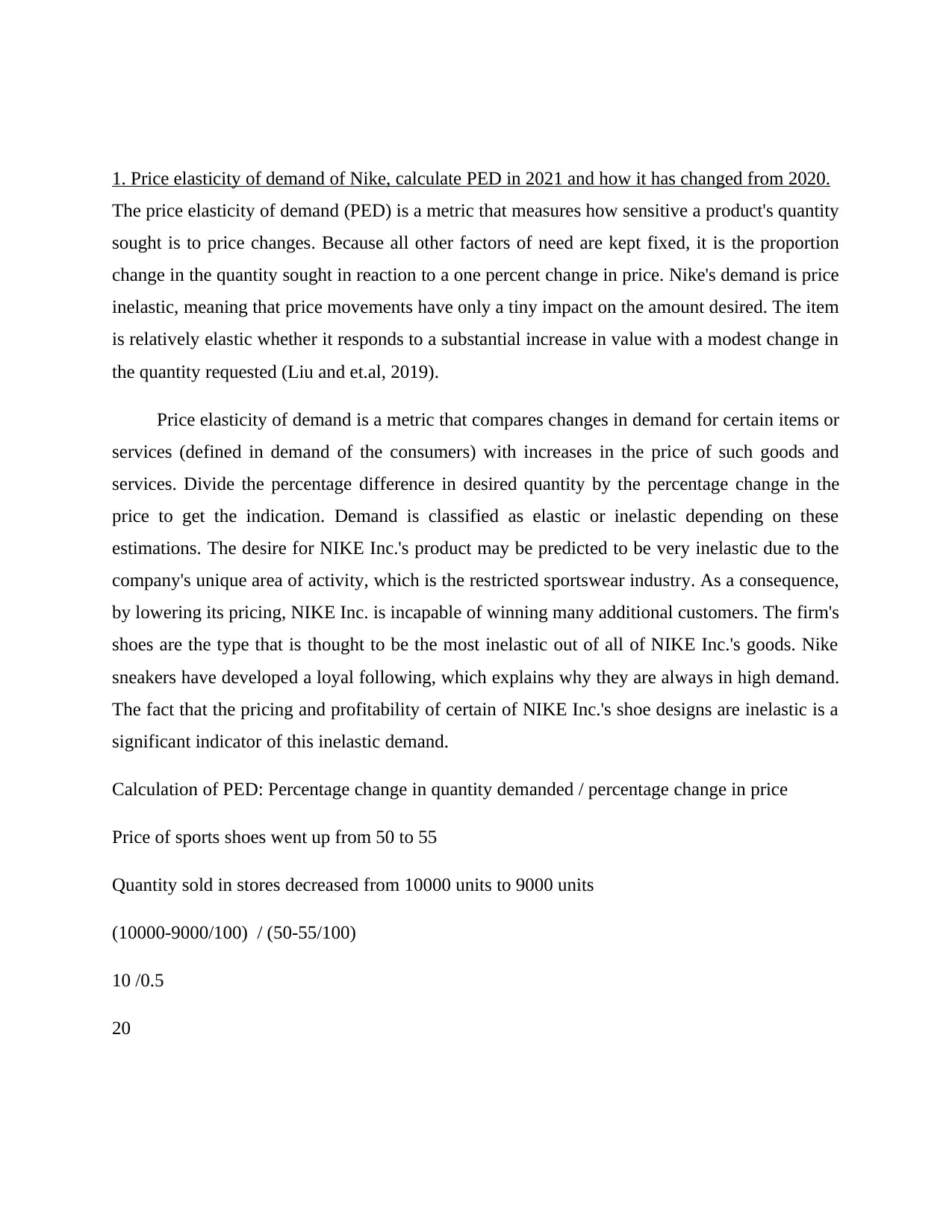
1. Price elasticity of demand of Nike, calculate PED in 2021 and how it has changed from 2020.
The price elasticity of demand (PED) is a metric that measures how sensitive a product's quantity
sought is to price changes. Because all other factors of need are kept fixed, it is the proportion
change in the quantity sought in reaction to a one percent change in price. Nike's demand is price
inelastic, meaning that price movements have only a tiny impact on the amount desired. The item
is relatively elastic whether it responds to a substantial increase in value with a modest change in
the quantity requested (Liu and et.al, 2019).
Price elasticity of demand is a metric that compares changes in demand for certain items or
services (defined in demand of the consumers) with increases in the price of such goods and
services. Divide the percentage difference in desired quantity by the percentage change in the
price to get the indication. Demand is classified as elastic or inelastic depending on these
estimations. The desire for NIKE Inc.'s product may be predicted to be very inelastic due to the
company's unique area of activity, which is the restricted sportswear industry. As a consequence,
by lowering its pricing, NIKE Inc. is incapable of winning many additional customers. The firm's
shoes are the type that is thought to be the most inelastic out of all of NIKE Inc.'s goods. Nike
sneakers have developed a loyal following, which explains why they are always in high demand.
The fact that the pricing and profitability of certain of NIKE Inc.'s shoe designs are inelastic is a
significant indicator of this inelastic demand.
Calculation of PED: Percentage change in quantity demanded / percentage change in price
Price of sports shoes went up from 50 to 55
Quantity sold in stores decreased from 10000 units to 9000 units
(10000-9000/100) / (50-55/100)
10 /0.5
20
The price elasticity of demand (PED) is a metric that measures how sensitive a product's quantity
sought is to price changes. Because all other factors of need are kept fixed, it is the proportion
change in the quantity sought in reaction to a one percent change in price. Nike's demand is price
inelastic, meaning that price movements have only a tiny impact on the amount desired. The item
is relatively elastic whether it responds to a substantial increase in value with a modest change in
the quantity requested (Liu and et.al, 2019).
Price elasticity of demand is a metric that compares changes in demand for certain items or
services (defined in demand of the consumers) with increases in the price of such goods and
services. Divide the percentage difference in desired quantity by the percentage change in the
price to get the indication. Demand is classified as elastic or inelastic depending on these
estimations. The desire for NIKE Inc.'s product may be predicted to be very inelastic due to the
company's unique area of activity, which is the restricted sportswear industry. As a consequence,
by lowering its pricing, NIKE Inc. is incapable of winning many additional customers. The firm's
shoes are the type that is thought to be the most inelastic out of all of NIKE Inc.'s goods. Nike
sneakers have developed a loyal following, which explains why they are always in high demand.
The fact that the pricing and profitability of certain of NIKE Inc.'s shoe designs are inelastic is a
significant indicator of this inelastic demand.
Calculation of PED: Percentage change in quantity demanded / percentage change in price
Price of sports shoes went up from 50 to 55
Quantity sold in stores decreased from 10000 units to 9000 units
(10000-9000/100) / (50-55/100)
10 /0.5
20
⊘ This is a preview!⊘
Do you want full access?
Subscribe today to unlock all pages.

Trusted by 1+ million students worldwide
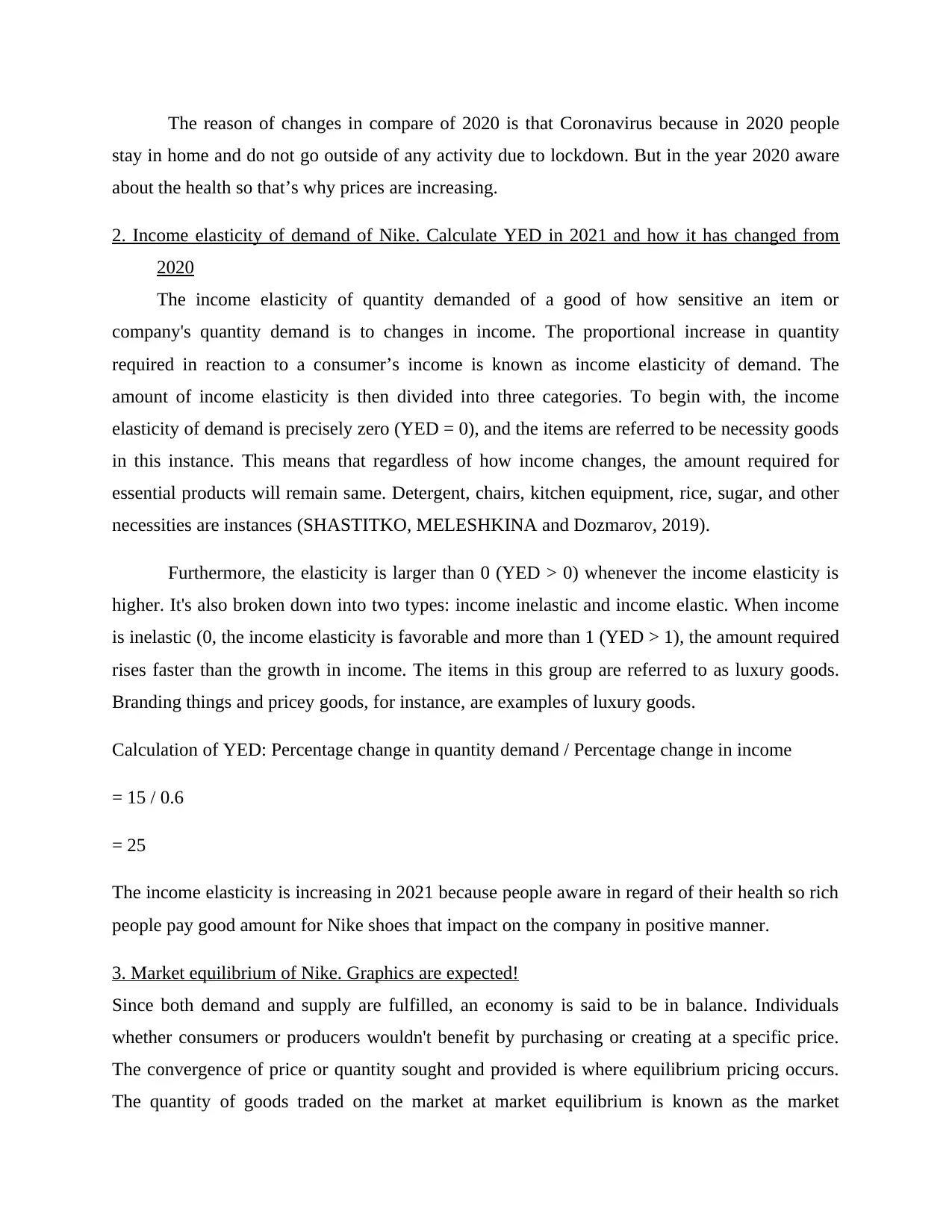
The reason of changes in compare of 2020 is that Coronavirus because in 2020 people
stay in home and do not go outside of any activity due to lockdown. But in the year 2020 aware
about the health so that’s why prices are increasing.
2. Income elasticity of demand of Nike. Calculate YED in 2021 and how it has changed from
2020
The income elasticity of quantity demanded of a good of how sensitive an item or
company's quantity demand is to changes in income. The proportional increase in quantity
required in reaction to a consumer’s income is known as income elasticity of demand. The
amount of income elasticity is then divided into three categories. To begin with, the income
elasticity of demand is precisely zero (YED = 0), and the items are referred to be necessity goods
in this instance. This means that regardless of how income changes, the amount required for
essential products will remain same. Detergent, chairs, kitchen equipment, rice, sugar, and other
necessities are instances (SHASTITKO, MELESHKINA and Dozmarov, 2019).
Furthermore, the elasticity is larger than 0 (YED > 0) whenever the income elasticity is
higher. It's also broken down into two types: income inelastic and income elastic. When income
is inelastic (0, the income elasticity is favorable and more than 1 (YED > 1), the amount required
rises faster than the growth in income. The items in this group are referred to as luxury goods.
Branding things and pricey goods, for instance, are examples of luxury goods.
Calculation of YED: Percentage change in quantity demand / Percentage change in income
= 15 / 0.6
= 25
The income elasticity is increasing in 2021 because people aware in regard of their health so rich
people pay good amount for Nike shoes that impact on the company in positive manner.
3. Market equilibrium of Nike. Graphics are expected!
Since both demand and supply are fulfilled, an economy is said to be in balance. Individuals
whether consumers or producers wouldn't benefit by purchasing or creating at a specific price.
The convergence of price or quantity sought and provided is where equilibrium pricing occurs.
The quantity of goods traded on the market at market equilibrium is known as the market
stay in home and do not go outside of any activity due to lockdown. But in the year 2020 aware
about the health so that’s why prices are increasing.
2. Income elasticity of demand of Nike. Calculate YED in 2021 and how it has changed from
2020
The income elasticity of quantity demanded of a good of how sensitive an item or
company's quantity demand is to changes in income. The proportional increase in quantity
required in reaction to a consumer’s income is known as income elasticity of demand. The
amount of income elasticity is then divided into three categories. To begin with, the income
elasticity of demand is precisely zero (YED = 0), and the items are referred to be necessity goods
in this instance. This means that regardless of how income changes, the amount required for
essential products will remain same. Detergent, chairs, kitchen equipment, rice, sugar, and other
necessities are instances (SHASTITKO, MELESHKINA and Dozmarov, 2019).
Furthermore, the elasticity is larger than 0 (YED > 0) whenever the income elasticity is
higher. It's also broken down into two types: income inelastic and income elastic. When income
is inelastic (0, the income elasticity is favorable and more than 1 (YED > 1), the amount required
rises faster than the growth in income. The items in this group are referred to as luxury goods.
Branding things and pricey goods, for instance, are examples of luxury goods.
Calculation of YED: Percentage change in quantity demand / Percentage change in income
= 15 / 0.6
= 25
The income elasticity is increasing in 2021 because people aware in regard of their health so rich
people pay good amount for Nike shoes that impact on the company in positive manner.
3. Market equilibrium of Nike. Graphics are expected!
Since both demand and supply are fulfilled, an economy is said to be in balance. Individuals
whether consumers or producers wouldn't benefit by purchasing or creating at a specific price.
The convergence of price or quantity sought and provided is where equilibrium pricing occurs.
The quantity of goods traded on the market at market equilibrium is known as the market
Paraphrase This Document
Need a fresh take? Get an instant paraphrase of this document with our AI Paraphraser
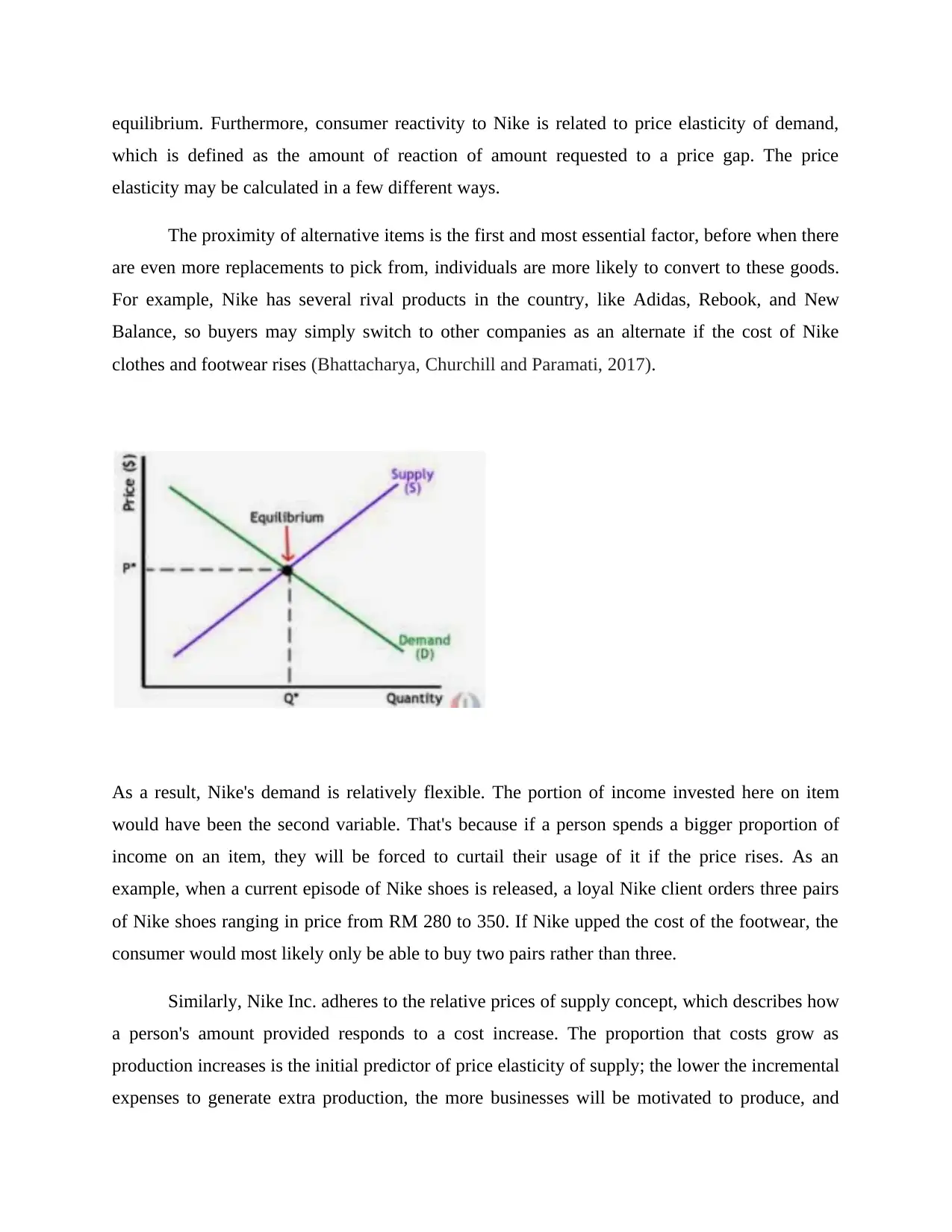
equilibrium. Furthermore, consumer reactivity to Nike is related to price elasticity of demand,
which is defined as the amount of reaction of amount requested to a price gap. The price
elasticity may be calculated in a few different ways.
The proximity of alternative items is the first and most essential factor, before when there
are even more replacements to pick from, individuals are more likely to convert to these goods.
For example, Nike has several rival products in the country, like Adidas, Rebook, and New
Balance, so buyers may simply switch to other companies as an alternate if the cost of Nike
clothes and footwear rises (Bhattacharya, Churchill and Paramati, 2017).
As a result, Nike's demand is relatively flexible. The portion of income invested here on item
would have been the second variable. That's because if a person spends a bigger proportion of
income on an item, they will be forced to curtail their usage of it if the price rises. As an
example, when a current episode of Nike shoes is released, a loyal Nike client orders three pairs
of Nike shoes ranging in price from RM 280 to 350. If Nike upped the cost of the footwear, the
consumer would most likely only be able to buy two pairs rather than three.
Similarly, Nike Inc. adheres to the relative prices of supply concept, which describes how
a person's amount provided responds to a cost increase. The proportion that costs grow as
production increases is the initial predictor of price elasticity of supply; the lower the incremental
expenses to generate extra production, the more businesses will be motivated to produce, and
which is defined as the amount of reaction of amount requested to a price gap. The price
elasticity may be calculated in a few different ways.
The proximity of alternative items is the first and most essential factor, before when there
are even more replacements to pick from, individuals are more likely to convert to these goods.
For example, Nike has several rival products in the country, like Adidas, Rebook, and New
Balance, so buyers may simply switch to other companies as an alternate if the cost of Nike
clothes and footwear rises (Bhattacharya, Churchill and Paramati, 2017).
As a result, Nike's demand is relatively flexible. The portion of income invested here on item
would have been the second variable. That's because if a person spends a bigger proportion of
income on an item, they will be forced to curtail their usage of it if the price rises. As an
example, when a current episode of Nike shoes is released, a loyal Nike client orders three pairs
of Nike shoes ranging in price from RM 280 to 350. If Nike upped the cost of the footwear, the
consumer would most likely only be able to buy two pairs rather than three.
Similarly, Nike Inc. adheres to the relative prices of supply concept, which describes how
a person's amount provided responds to a cost increase. The proportion that costs grow as
production increases is the initial predictor of price elasticity of supply; the lower the incremental
expenses to generate extra production, the more businesses will be motivated to produce, and

thus the stock is elastic. The timeframe is also a factor in determining supply price elasticity.
Whenever supply is inelastic, it is owing to the impossibility of raising supply quickly (Biddle
and Milor, 2018).
Whenever supply is inelastic, it is owing to the impossibility of raising supply quickly (Biddle
and Milor, 2018).
⊘ This is a preview!⊘
Do you want full access?
Subscribe today to unlock all pages.

Trusted by 1+ million students worldwide
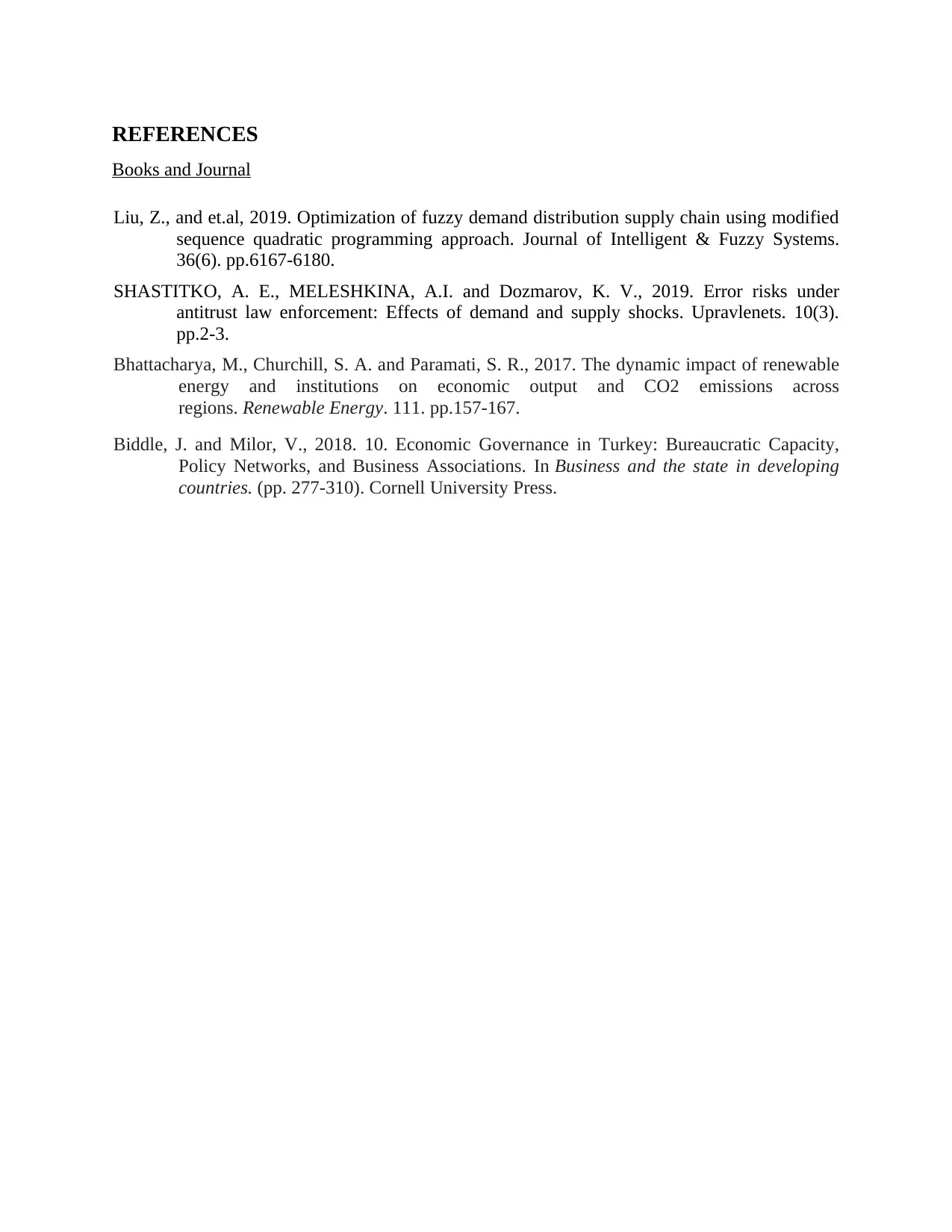
REFERENCES
Books and Journal
Liu, Z., and et.al, 2019. Optimization of fuzzy demand distribution supply chain using modified
sequence quadratic programming approach. Journal of Intelligent & Fuzzy Systems.
36(6). pp.6167-6180.
SHASTITKO, A. E., MELESHKINA, A.I. and Dozmarov, K. V., 2019. Error risks under
antitrust law enforcement: Effects of demand and supply shocks. Upravlenets. 10(3).
pp.2-3.
Bhattacharya, M., Churchill, S. A. and Paramati, S. R., 2017. The dynamic impact of renewable
energy and institutions on economic output and CO2 emissions across
regions. Renewable Energy. 111. pp.157-167.
Biddle, J. and Milor, V., 2018. 10. Economic Governance in Turkey: Bureaucratic Capacity,
Policy Networks, and Business Associations. In Business and the state in developing
countries. (pp. 277-310). Cornell University Press.
Books and Journal
Liu, Z., and et.al, 2019. Optimization of fuzzy demand distribution supply chain using modified
sequence quadratic programming approach. Journal of Intelligent & Fuzzy Systems.
36(6). pp.6167-6180.
SHASTITKO, A. E., MELESHKINA, A.I. and Dozmarov, K. V., 2019. Error risks under
antitrust law enforcement: Effects of demand and supply shocks. Upravlenets. 10(3).
pp.2-3.
Bhattacharya, M., Churchill, S. A. and Paramati, S. R., 2017. The dynamic impact of renewable
energy and institutions on economic output and CO2 emissions across
regions. Renewable Energy. 111. pp.157-167.
Biddle, J. and Milor, V., 2018. 10. Economic Governance in Turkey: Bureaucratic Capacity,
Policy Networks, and Business Associations. In Business and the state in developing
countries. (pp. 277-310). Cornell University Press.
1 out of 7
Your All-in-One AI-Powered Toolkit for Academic Success.
+13062052269
info@desklib.com
Available 24*7 on WhatsApp / Email
![[object Object]](/_next/static/media/star-bottom.7253800d.svg)
Unlock your academic potential
Copyright © 2020–2025 A2Z Services. All Rights Reserved. Developed and managed by ZUCOL.


